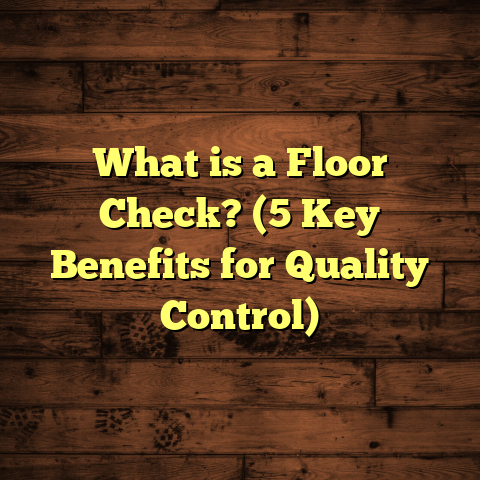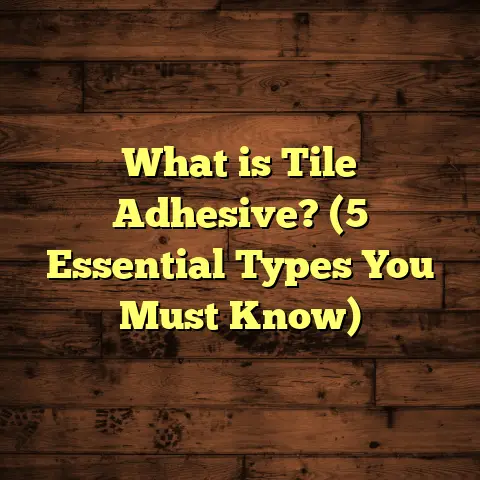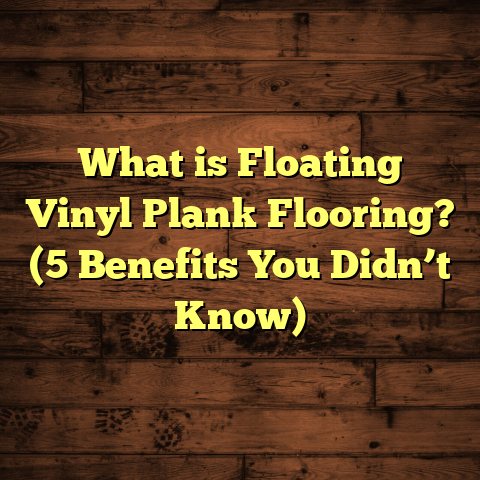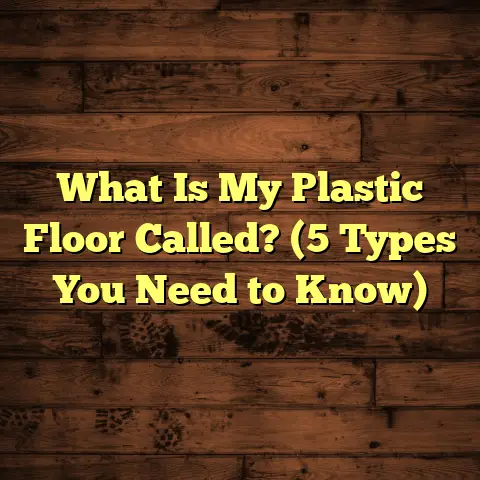What is Old Parquet Flooring? (5 Essential Facts You Need)
I still remember the first time I stepped into a house that had old parquet flooring. The moment my feet touched the floor, I was captivated by the intricate patterns beneath me—tiny pieces of wood laid out like a beautifully crafted puzzle. That floor wasn’t just a surface; it was a piece of history, a work of art, and a testament to craftsmanship. Over the years, I’ve worked with many homes that feature old parquet floors, restoring them, maintaining them, and sometimes even helping homeowners understand their value. If you’ve ever been curious about what old parquet flooring really is or why it commands such admiration, I’m here to share everything I’ve learned—from definitions to maintenance tips, and even some stories from the field.
What is Old Parquet Flooring?
Old parquet flooring is a type of hardwood flooring made by assembling small pieces of wood in geometric patterns. Unlike traditional hardwood floors that consist of long planks laid side-by-side, parquet flooring uses smaller wood blocks or strips arranged in repeating designs. This technique dates back several centuries, first gaining popularity in European palaces and estates during the 17th century.
The word “parquet” itself comes from the French term for a small enclosed space or compartment. This makes sense because parquet floors are essentially floors made up of many small wooden compartments fitted together precisely.
The Craftsmanship Behind Old Parquet Floors
What sets old parquet floors apart is the incredible craftsmanship involved. Each piece of wood had to be cut, shaped, and fitted meticulously by hand. The wood species often used were high-quality hardwoods such as oak, walnut, cherry, and mahogany. These woods were prized for their durability and natural beauty.
The blocks were glued or nailed down onto a subfloor, often made of concrete or wooden planks. The precision needed to keep the pattern tight and seamless was high—any misalignment was very noticeable.
I’ve seen parquet floors with patterns so complex they look like mosaics or tapestries laid flat on the floor. The designs could be simple—like classic herringbone or chevron—or incredibly ornate with multiple wood tones and shapes forming stars, circles, or floral motifs.
Why Old Parquet Flooring Still Matters
Old parquet floors aren’t just about looks. They represent a snapshot of architectural style and social history. Because they were expensive and labor-intensive to install, homes with original parquet floors usually indicate a certain era or status.
In my career, whenever I encounter homes with original parquet flooring intact, I treat them almost like artifacts that deserve respect and preservation. These floors tell stories—not just of the families who lived on them but also of the craftsmen who built them.
5 Essential Facts You Need About Old Parquet Flooring
Let me break down five key facts based on my professional experience and research that will help you understand old parquet flooring better than most people.
1. The Patterns Are What Make It Special
If you walk across an old parquet floor and don’t stop to admire the pattern, you’re missing half the story. The arrangement of wood pieces is what defines parquet flooring’s unique charm.
Common Patterns
- Herringbone: Rectangular blocks arranged in a zigzag pattern, creating a “V” shape across the floor.
- Chevron: Similar to herringbone but with blocks cut at angles to form continuous “V” shapes.
- Basket Weave: Blocks paired side-by-side creating square “baskets” repeated across the floor.
- Versailles: Large squares made up of smaller blocks arranged into intricate geometric designs.
- Brick Pattern: Offset rectangular blocks resembling brickwork.
Each pattern creates a different feel in a room. Herringbone tends to add movement and energy. Chevron looks sharp and modern despite being traditional. Basket weave feels cozy and classic.
I remember working on an old Victorian home where the parquet floor combined herringbone with walnut and cherry wood blocks, creating striking contrast. It was like walking on a piece of fine art every day.
Why Patterns Matter Beyond Looks
Patterns also impact how light interacts with the floor. The direction of wood grain and block arrangement can make rooms feel larger or warmer depending on how they catch sunlight.
In a project for a client whose living room faced north (and felt dark), we chose a lighter oak parquet in a chevron pattern to brighten and open up the space visually.
2. It’s Durable but Needs Careful Maintenance
Old parquet flooring can last for generations if taken care of properly. Hardwood species like oak or walnut are naturally hardwearing. However, because parquet consists of many small glued pieces, it has unique vulnerabilities compared to plank hardwood floors.
How Durable Is Old Parquet Flooring?
A National Wood Flooring Association study found that hardwood floors can last over 100 years with good maintenance. Many homes I’ve worked on had parquet floors installed 70-100 years ago and still looked great after restoration.
However, small gaps can form over time as wood expands and contracts with humidity changes. Water damage is especially dangerous because moisture can loosen adhesive bonds between blocks.
Common Problems I’ve Encountered
- Lifting Blocks: Water exposure or poor installation causes blocks to come loose.
- Scratches & Wear: High traffic areas show finish wear faster.
- Gaps & Cracks: Seasonal humidity swings cause wood pieces to shrink or expand.
One tough case involved a 1940s floor damaged by flooding. Several blocks had lifted and warped. We had to carefully remove damaged pieces, dry out the subfloor, then reinstall matching blocks from spare stock.
Maintenance Tips That Work
- Avoid excessive water during cleaning; damp mop only.
- Use mild pH-neutral cleaners designed for hardwood.
- Keep indoor humidity stable between 35%-55%.
- Regularly check for loose blocks or gaps.
- Refinish every 10-15 years depending on wear.
3. Old Parquet Floors Can Be Restored Rather Than Replaced
One thing I tell clients all the time: don’t replace that old parquet floor unless you absolutely have to. Restoration can bring back the original beauty at a fraction of replacement cost.
Restoration Process Overview
- Assessment: Check for structural issues, moisture damage, loose blocks.
- Cleaning & Repairs: Remove surface dirt, fix loose or missing blocks.
- Sanding: Level surface carefully without damaging pattern edges.
- Staining (Optional): Match original colors or update look.
- Refinishing: Apply durable finish coats (polyurethane or oil-based).
In one memorable project in an old Boston townhouse, the parquet floor had deep scratches and dull finish from decades of wear. After sanding and applying five coats of finish, it shone again like new—and that homeowner was thrilled.
Cost Considerations
Restoration usually costs between $3-$6 per square foot depending on damage level and finish type. New parquet installation can cost $8-$15 per square foot or more due to labor intensity.
A restored floor also keeps historic integrity intact—a big plus for buyers in older neighborhoods.
4. Parquet Flooring Has Unique Installation Challenges
Installing or repairing old-style parquet flooring isn’t straightforward like laying down plank hardwood. The small size of the blocks and complex patterns require special skills and precision.
Why Installation Is Tricky
Each block must fit tightly next to others without gaps. Misalignment spoils the whole pattern visually. Also, traditional parquet floors were often glued down directly onto concrete or wooden subfloors without modern underlayment.
When training new installers, I stress patience and accuracy above all else. Even tiny errors compound quickly when repeated across hundreds of blocks.
Tools and Techniques Used
- Specialized saws for cutting small blocks precisely.
- Adhesives suited for specific subfloor types.
- Templates or guides for maintaining pattern alignment.
- Moisture barriers under concrete slabs to prevent damage.
An interesting challenge came up during a restoration job in an old Paris apartment where original blocks had to be custom-cut to replace damaged ones exactly matching grain direction and color.
5. It Adds Real Value to Historic Homes
Old parquet flooring does more than beautify—it can add substantial market value to period homes. Buyers recognize the quality and timeless appeal that comes with original parquet floors.
Impact on Property Value
A recent case involved a home listed at $500,000 with well-maintained original parquet floors. After minor restoration work, the property’s value increased by nearly 7% compared to similar homes without such features.
The National Association of Realtors found homes with original hardwood floors generally sell faster and at higher prices than those without any hardwood features.
Emotional Appeal
Parquet floors evoke nostalgia and character you rarely find in modern construction. Several homeowners I’ve met said their decision to buy was influenced heavily by seeing original floors in good condition.
My Personal Stories With Old Parquet Floors
I’ve shared many stories about old parquet floors over my career but here are some that stand out:
The Family Legacy Floor
I once restored a 1920s floor in an elderly woman’s home where every block was hand-laid by her grandfather who was a craftsman. She told me how holidays were spent dancing on that very floor. Working there felt like preserving family history rather than just fixing wood.
The Flooded Basement Rescue
A basement apartment had flooding damage that partially ruined its parquet floor. We carefully removed damaged blocks instead of ripping up everything, salvaging about 80% of the original floor. The owners were amazed at how beautiful it looked afterward.
The Modern Twist Project
In a renovation project for a client who loved vintage design but wanted something fresh, we installed new parquet flooring using reclaimed wood stained in modern gray tones. It blended old-world craftsmanship with contemporary style perfectly.
How Old Parquet Flooring Compares To Other Flooring Types
You might be wondering how old parquet stands up against other popular flooring options:
| Feature | Old Parquet Flooring | Engineered Hardwood | Laminate Flooring | Traditional Hardwood Plank |
|---|---|---|---|---|
| Durability | Very durable if maintained; vulnerable to moisture | Stable with moisture-resistant layers | Scratch-resistant but less authentic feel | Durable but wider planks can warp |
| Aesthetic | Intricate patterns; timeless elegance | Looks like hardwood but less pattern variety | Mimics wood but flat; no real grain depth | Classic plank look; natural grain |
| Installation | Labor-intensive; requires skill | Easier than parquet; tongue & groove systems | Easy DIY installation | Moderate difficulty; plank alignment |
| Cost | Moderate to high; restoration cheaper than new install | Moderate; varies by quality | Low-cost option | Moderate-high depending on wood species |
| Maintenance | Requires careful moisture control | Easier maintenance due to factory finishes | Low maintenance | Can be sanded/refinished multiple times |
Tips for Maintaining Old Parquet Floors
From my years of hands-on experience restoring these floors, here are practical tips you can use:
- Handle Moisture with Care: Use only slightly damp mops; never soak your floor.
- Immediate Spill Cleanup: Wood is porous; liquids left too long cause stains or warping.
- Use Gentle Cleaners: Avoid harsh chemicals that degrade finish or glue.
- Protect High-Traffic Areas: Use rugs or runners in entryways.
- Furniture Pads: Prevent scratches by placing felt pads under furniture legs.
- Monitor Humidity: Wood expands/shrinks with humidity; keep indoor levels steady.
- Regular Inspections: Look for loose blocks early before damage worsens.
- Periodic Refinishing: Sanding and reapplying finish every decade or so keeps floors looking fresh.
Conclusion
Old parquet flooring is truly something special—an intersection of art, history, and durable craftsmanship. From their unique patterns and intricate installation to their potential for restoration and value addition, these floors offer much more than meets the eye.
Whether you’re stepping onto one for the first time or considering restoring your own, appreciating what makes old parquet unique will help you care for it properly and enjoy its warmth for many years ahead.
Have questions about your old parquet floor? Want tips specific to your home? Just ask—I’ve got plenty more stories and advice from experience waiting to share!





